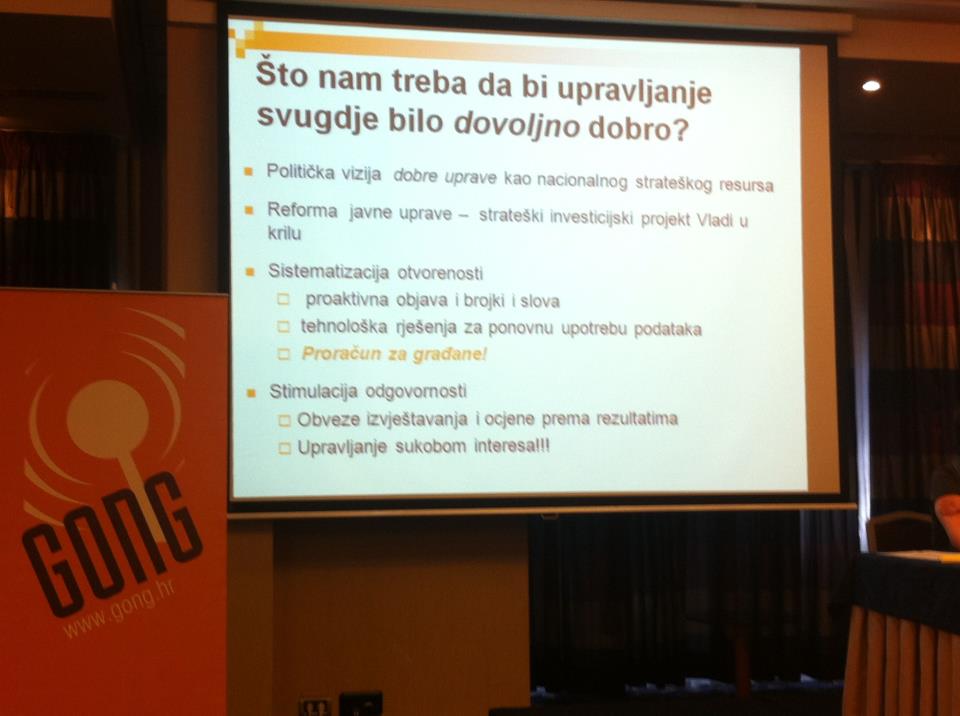Budget openness (transparency) provides a possibility for citizens to access complete, relevant, accurate, timely and comprehensible information on budgets of state institutions, which rightfully belong to citizens to use – it has been pointed out during a thematic discussion “Transparency of the budgetary and public procurement process” at the conference “Right to Good Administration in Croatian Practice” organized by GONG.
The probability of citizen participation increases with the transparency of the budgetary process. The same is true for the accountability of the governments for implemented policies, as well as for the results achieved and the modalities of the state budget expenditures. In addition, the quality, relevance and efficiency of the government policies, as well as their understanding and support of beneficiaries could be improved.
However, state institutions do not encourage citizens to cooperate on the issues of their budget while the citizens find the budgets incomprehensible and/or lack sufficient time for analysis; often they regard that nothing can be done, and consequently do not deal with budgets of state institutions.
The Ministry of Finance should define minimum standards and good practice for citizen and interested public participation in the process of planning budgets of state institutions and, in order for these practices to take root, explicitly invite other Ministries to implement them. In addition, at the level of individual state institutions and budgetary programmes, it is necessary to carry out several public consultations on the budget drafts.
Mihaela Bronić from the Institute of Public Finance warned – “The volume of the comprehensive compilation of budgetary documents published for all state budget users is too extensive, and for the citizens it is both difficult to find and comprehend. In the adopted State Budget for 2013 and projections for 2014 and 1015, the key table which contains expenditures by users and programmes is presented on 206 pages.” Pavol Lacko pointed out: “Not only is it important that the information is published, but also the way it is published is crucial”s. He is a representative of the CSO Aliancia Fair-play from Slovakia, whose database Datanest monitors the public money cash flow.
From stars to hardships
Not a single institution has published a budget summary adjusted for citizens.It is necessary to present the budget to the citizens in a comprehensible manner, with an explanation of its rationale, structure, savings and investment strategies, as well as priorities and main changes compared to the previous year. The good practice requires the budget to be submitted to the Parliament at least three months prior to the beginning of the fiscal year, however in Croatia, in 2012 the budget draft was submitted to the Parliament only 41 days before the beginning of the fiscal year.
Transparency and accountability of the government and citizens’ participation are connected in a circle. However, one part of the government thinks that transparency is achieved merely by Facebook posts and tweets which is completely false and does not contribute to a rational discussion. On the contrary, it represents a transparency surrogate. The other part regard that it is sufficient to gather up journalists and tell them their story, but this is not enough, because the data thus provided are filtered to accommodate the needs in that the moment. When we speak of accountability, it is also very questionable, because legal requirements are not met in regards to deadlines or to the content of documents, and each delay causes a new delay, whereas the consequence of data inconsistency is embarrassment”, Katarina Ott, the Director of The Institute of Public Finance cautioned.
Among numerous examples mentioned, she pinpointed one obvious example of irresponsibility and non-transparency, “If you click on the Public Debt web publication, then you will see that the last annual report available is the one from 2006 when the debt amounted to 100 bilion kuna, and last year it amounted to 180 bilion kuna.”
